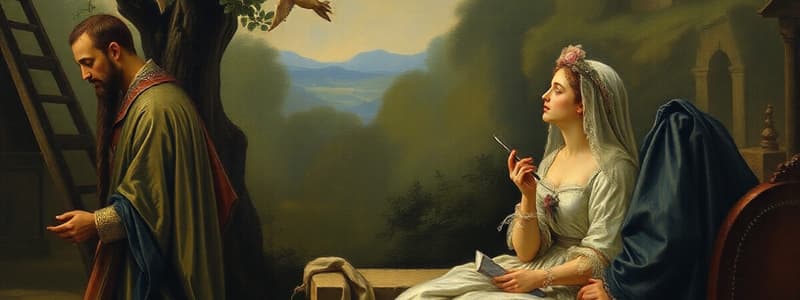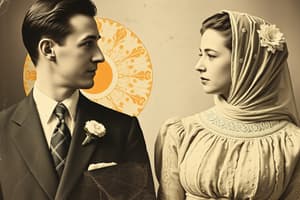Podcast
Questions and Answers
Which aspect of marriage significantly changed during the Reformation?
Which aspect of marriage significantly changed during the Reformation?
- Increased power of church priests
- Marriage became less formalized
- Restrictions on divorce were tightened
- The introduction of civil marriage (correct)
What was considered a significant factor in marriages during the Ancient Era?
What was considered a significant factor in marriages during the Ancient Era?
- Formal marriage ceremonies were mandatory
- Monogamous relationships were strictly enforced
- Same social class requirement for spouses (correct)
- Emphasis on emotional attachment
What was a notable shift in marriage practices during the Middle Ages?
What was a notable shift in marriage practices during the Middle Ages?
- Couples had to be married at older ages
- Public announcements of marriage became required (correct)
- Marriage was preferred to chastity
- Priests lost influence over marriage rites
Which document by Pope Paul VI addresses topics related to marriage and family?
Which document by Pope Paul VI addresses topics related to marriage and family?
During Vatican II, what did the church emphasize in relation to marriage?
During Vatican II, what did the church emphasize in relation to marriage?
Flashcards are hidden until you start studying
Study Notes
Ancient Era
- Pagans practiced strictly monogamous marriages
- Modestinus, a Roman jurist, defined marriage as a life-long union between a man and a woman, ordained by both divine and human law
- Societal class was a crucial factor in marriage, with unions typically occurring within the same social stratum
- Political and social considerations often drove marriage decisions rather than formal ceremonies.
- Not all women were permitted to marry, highlighting societal restrictions.
- Dowries, bride prices, and inheritance provisions provided some level of financial independence for women.
- Although marriage was honored, the concept of affectio moritalis (affectionate intention) was sometimes absent, meaning unions were not necessarily based on love.
Middle Ages
- The rise of Christianity significantly influenced marriage practices.
- Chastity was often valued over marriage.
- Priests gained greater authority and influence.
- Church marriages gained legal recognition through state endorsement.
- Free and voluntary consent was emphasized, prohibiting coercion.
- Popes Alexander III and Innocent III standardized the marriage rites within the Church.
- Minimum ages for marriage were established, with girls at 12 and boys at 14.
- The public announcement of intended marriages through "banns" became customary.
Reformation
- Martin Luther, a key figure in the Protestant Reformation, established a new church structure.
- The concept of "civil marriage" was introduced, separating marriage from strictly religious control.
- Municipal and royal authorities played a growing role in regulating marriage.
- Divorce became an option, challenging the traditional notion of indissoluble marriage.
Vatican II
- The Vatican II Council (1962-1965) marked a period of reform within the Catholic Church, aiming to address contemporary challenges.
- Encyclicals (official letters) focused on marriage and family issues.
- Pope Paul VI issued Humanae Vitae (1968), addressing contraception, responsible parenthood, and the dignity of marriage.
- Pope John Paul II emphasized the sanctity of marriage in Familiaris Consortio (1981) and addressed threats to life in Evangelium Vitae (1995).
- Pope Francis adopted a pastoral approach in Amoris Laetitia (2016), emphasizing mercy and understanding in addressing complex family situations.
Studying That Suits You
Use AI to generate personalized quizzes and flashcards to suit your learning preferences.




